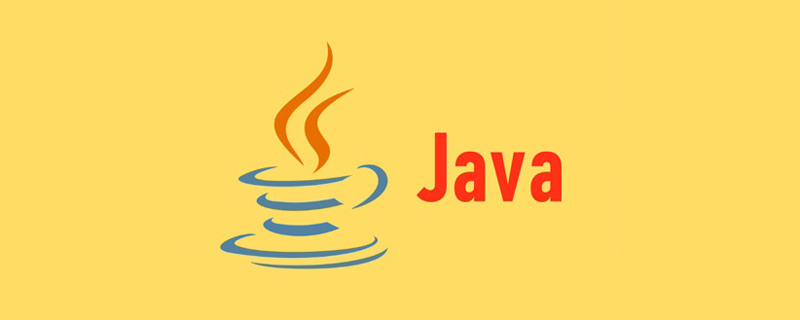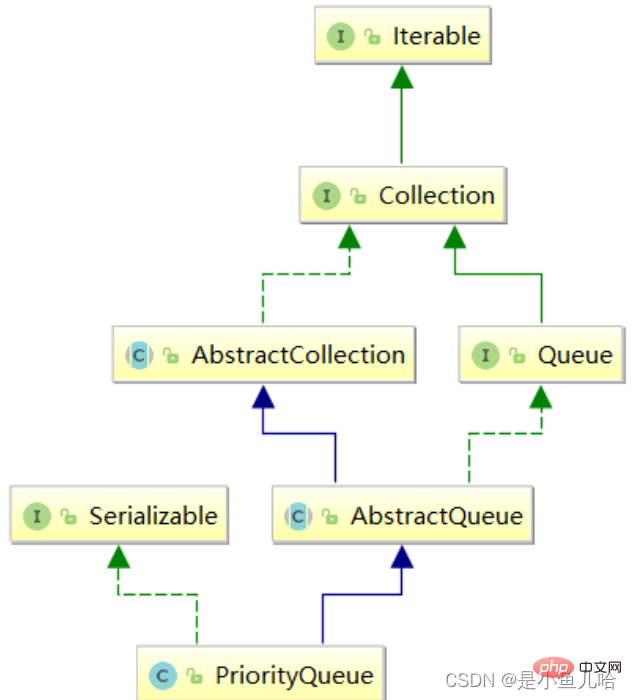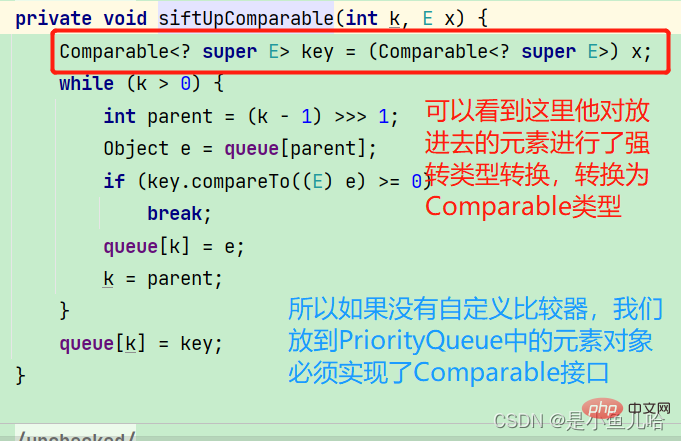PriorityQueue priority queue of Java collection framework
This article brings you relevant knowledge about java, which mainly introduces the relevant knowledge about PriorityQueue priority queue. The Java collection framework provides two types of priorities, PriorityQueue and PriorityBlockingQueue. Level queue, PriorityQueue is thread-unsafe, and PriorityBlockingQueue is thread-safe. Let’s take a look at it together. I hope it will be helpful to everyone.

Recommended study: "java Video Tutorial"
The Java collection framework provides two types of PriorityQueue and PriorityBlockingQueue The priority queue, PriorityQueue is thread-unsafe, and PriorityBlockingQueue is thread-safe. This article mainly introduces PriorityQueue
The relationship of priorityQueue in the Java collection framework is as follows:

1. Points to note when using PriorityQueue
1. When using it, you must import the package where PriorityQueue is located, that is:
import java. util.PriorityQueue
2. The elements placed in the PriorityQueue must be able to be compared in size, and objects that cannot be compared in size cannot be inserted, otherwise
ClassCastException## will be thrown.
time complexity of inserting and deleting elements is log base 2 n
6. The bottom layer of PriorityQueue uses a heap data structure7. PriorityQueue by default It is a small heap---that is, the elements obtained every time are the smallest elements (If we want to turn it into a large heap, we need to re-compare the method. The default comparison method is the compareTo method in the Comparable interface)
2. Introduction to Common Interfaces of PriorityQueue1. Construction of Priority QueueHere are just a few common construction methods inPriorityQueue, for others, you can refer to the help documentation.
| Function introduction | |
| Create an empty Priority queue, | The default capacity is 11 |
| initialCapacity) | Create a initial capacity is initialCapacity Priority queue, Note: initialCapacity cannot be less than 1, otherwise an IllegalArgumentException will be thrown Often |
##PriorityQueue(Comparator comparator) | with default initial capacity and compare its elements against the specified comparator |
PriorityQueue(int initialCapacity, Comparator comparator) | Create a Initial capacity is initialCapacity initialCapacity cannot be less than 1, otherwise IllegalArgumentException will be thrown Often |
| Function Name | Function introduction |
| boolean offer(E e) |
Insert element e, and return true if the insertion is successful, if the e object is empty , throwing NullPointerException, time complexity, note: when the space is not enough, it will be expanded |
| Get the element with the highest priority , if the priority queue is empty, return null | |
| Remove the highest priority element and return, if the priority queue is empty, return null | |
| Get the number of valid elements | |
| clear() | Clear|
| boolean isEmty() | Check whether the priority queue is empty and return if empty true
java video tutorial"
The above is the detailed content of PriorityQueue priority queue of Java collection framework. For more information, please follow other related articles on the PHP Chinese website!

Hot AI Tools

Undresser.AI Undress
AI-powered app for creating realistic nude photos

AI Clothes Remover
Online AI tool for removing clothes from photos.

Undress AI Tool
Undress images for free

Clothoff.io
AI clothes remover

Video Face Swap
Swap faces in any video effortlessly with our completely free AI face swap tool!

Hot Article

Hot Tools

Notepad++7.3.1
Easy-to-use and free code editor

SublimeText3 Chinese version
Chinese version, very easy to use

Zend Studio 13.0.1
Powerful PHP integrated development environment

Dreamweaver CS6
Visual web development tools

SublimeText3 Mac version
God-level code editing software (SublimeText3)

Hot Topics
 1664
1664
 14
14
 1423
1423
 52
52
 1317
1317
 25
25
 1268
1268
 29
29
 1248
1248
 24
24
 Break or return from Java 8 stream forEach?
Feb 07, 2025 pm 12:09 PM
Break or return from Java 8 stream forEach?
Feb 07, 2025 pm 12:09 PM
Java 8 introduces the Stream API, providing a powerful and expressive way to process data collections. However, a common question when using Stream is: How to break or return from a forEach operation? Traditional loops allow for early interruption or return, but Stream's forEach method does not directly support this method. This article will explain the reasons and explore alternative methods for implementing premature termination in Stream processing systems. Further reading: Java Stream API improvements Understand Stream forEach The forEach method is a terminal operation that performs one operation on each element in the Stream. Its design intention is
 PHP: A Key Language for Web Development
Apr 13, 2025 am 12:08 AM
PHP: A Key Language for Web Development
Apr 13, 2025 am 12:08 AM
PHP is a scripting language widely used on the server side, especially suitable for web development. 1.PHP can embed HTML, process HTTP requests and responses, and supports a variety of databases. 2.PHP is used to generate dynamic web content, process form data, access databases, etc., with strong community support and open source resources. 3. PHP is an interpreted language, and the execution process includes lexical analysis, grammatical analysis, compilation and execution. 4.PHP can be combined with MySQL for advanced applications such as user registration systems. 5. When debugging PHP, you can use functions such as error_reporting() and var_dump(). 6. Optimize PHP code to use caching mechanisms, optimize database queries and use built-in functions. 7
 PHP vs. Python: Understanding the Differences
Apr 11, 2025 am 12:15 AM
PHP vs. Python: Understanding the Differences
Apr 11, 2025 am 12:15 AM
PHP and Python each have their own advantages, and the choice should be based on project requirements. 1.PHP is suitable for web development, with simple syntax and high execution efficiency. 2. Python is suitable for data science and machine learning, with concise syntax and rich libraries.
 PHP vs. Other Languages: A Comparison
Apr 13, 2025 am 12:19 AM
PHP vs. Other Languages: A Comparison
Apr 13, 2025 am 12:19 AM
PHP is suitable for web development, especially in rapid development and processing dynamic content, but is not good at data science and enterprise-level applications. Compared with Python, PHP has more advantages in web development, but is not as good as Python in the field of data science; compared with Java, PHP performs worse in enterprise-level applications, but is more flexible in web development; compared with JavaScript, PHP is more concise in back-end development, but is not as good as JavaScript in front-end development.
 PHP vs. Python: Core Features and Functionality
Apr 13, 2025 am 12:16 AM
PHP vs. Python: Core Features and Functionality
Apr 13, 2025 am 12:16 AM
PHP and Python each have their own advantages and are suitable for different scenarios. 1.PHP is suitable for web development and provides built-in web servers and rich function libraries. 2. Python is suitable for data science and machine learning, with concise syntax and a powerful standard library. When choosing, it should be decided based on project requirements.
 PHP's Impact: Web Development and Beyond
Apr 18, 2025 am 12:10 AM
PHP's Impact: Web Development and Beyond
Apr 18, 2025 am 12:10 AM
PHPhassignificantlyimpactedwebdevelopmentandextendsbeyondit.1)ItpowersmajorplatformslikeWordPressandexcelsindatabaseinteractions.2)PHP'sadaptabilityallowsittoscaleforlargeapplicationsusingframeworkslikeLaravel.3)Beyondweb,PHPisusedincommand-linescrip
 Java Program to Find the Volume of Capsule
Feb 07, 2025 am 11:37 AM
Java Program to Find the Volume of Capsule
Feb 07, 2025 am 11:37 AM
Capsules are three-dimensional geometric figures, composed of a cylinder and a hemisphere at both ends. The volume of the capsule can be calculated by adding the volume of the cylinder and the volume of the hemisphere at both ends. This tutorial will discuss how to calculate the volume of a given capsule in Java using different methods. Capsule volume formula The formula for capsule volume is as follows: Capsule volume = Cylindrical volume Volume Two hemisphere volume in, r: The radius of the hemisphere. h: The height of the cylinder (excluding the hemisphere). Example 1 enter Radius = 5 units Height = 10 units Output Volume = 1570.8 cubic units explain Calculate volume using formula: Volume = π × r2 × h (4
 PHP: The Foundation of Many Websites
Apr 13, 2025 am 12:07 AM
PHP: The Foundation of Many Websites
Apr 13, 2025 am 12:07 AM
The reasons why PHP is the preferred technology stack for many websites include its ease of use, strong community support, and widespread use. 1) Easy to learn and use, suitable for beginners. 2) Have a huge developer community and rich resources. 3) Widely used in WordPress, Drupal and other platforms. 4) Integrate tightly with web servers to simplify development deployment.







 It seems that there is a problem when inserting elements into PriorityQueue
It seems that there is a problem when inserting elements into PriorityQueue 





